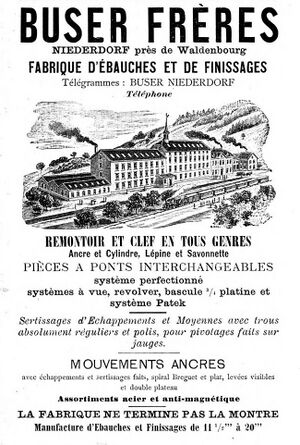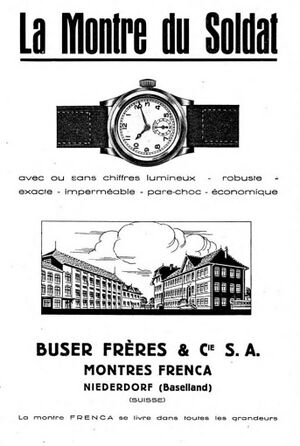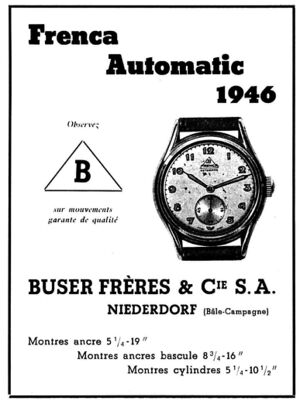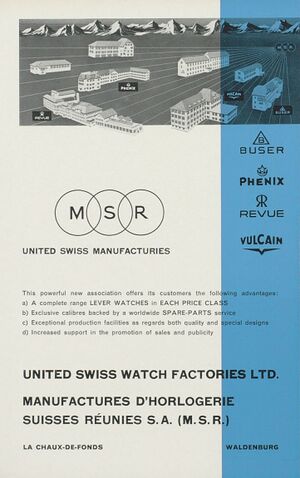Buser Frères
- Not to be confused with MB&F (Max Büsser and Friends)
Buser Frères, maker of Frenca brand watches, was a watchmaker in Canton Basel-Landschaft, Switzerland, founded in 1891. In 1961 Buser joined Revue Thommen, Phenix, and Vulcain in the holding company known as MSR. After decades of independence, Buser was dissolved and merged into MSR on May 31, 1995.
The Buser family later became involved in the Swisstime concern.
Buser Frères & Berger
On September 8, 1891, Albert Buser-Weber, Fritz Buser-Bider, and Johannes ("Hans") Buser of Waldenburg joined with Albert Berger-Haas, also of Waldenburg, to form a new watchmaking company. Called Gebrüder Buser & Berger (Buser Frères et Berger), the company was initially located in Waldenburg.
A. Buser in Alsace
Around 1895, Albert Buser founded an ebauche factory in Gros-Hüningen (Alsace) to produce ebauches for the German market. Called A. Buser & Co., the firm produced clones of existing Swiss watch movements both on-site and using Swiss components. Workers were recruited from Waldenburg and Grenchen to man the factory, which was funded using an investment by a Mr. Baur of Basel.
On October 7, 1898 a criminal court there found that Buser was illegally copying Swiss movements to avoid import duties. The company was also producing watches using a cheaper, lower-quality silver alloy with copper plating and stamping this with the hallmark of a higher-quality material.
It was noted that "Hans Buser" had split from his brother Albert at this time, despite being initial manager of the Hüningen factory. It is likely that the Buser factory in Alsace was closed as a result of this verdict.
Buser Frères & Lohner
As noted above, Johannes "Hans" Buser-Tièche left the company in 1894, with Albert Berger-Haas perhaps also leaving the partnership. The remaining brothers, Albert Buser-Weber and Fritz Buser-Bieder, brought Arnold Lohner-Leuenberger of Grindelwald in as a new partner. The company was renamed Gebrüder Buser & Lohner (Buser Frères & Lohner) from this point.
In 1902, Buser Frères & Lohner was dissolved as Arnold Lohner left. He formed a new factory in Hölstein that would be the predecessor to Oris.
Buser Frères

Albert Buser-Weber and Fritz Buser-Bieder formed a new company in 1904 called simply Gebrüder Buser (Buser Frères) in Niederdorf on January 1, 1902. This firm took over the assets and liabilities of the dissolved company "Buser Frères & Lohner". Emil Heger of La Chaux-de-Fonds was granted power of attorney at this time, but it was revoked the following February.
A 1908 advertisement shows the large factory in Niederdorf and advertises that the company produces watches of all kinds: Anchor and cylinder, Lépine and savonnette, with interchangeable bridges from 11 1⁄3 to 20 lignes. This suggests that the company's products were largely used to produce watches similar to name-brands, including "système Patek".
In July 1913 Gebrüder Buser (Buser Frères) of Niederdorf was taken over by a new company called "Albert Buser". The owner of the company was Albert Buser, with Ernst Zimmermann, from Kempfhof-Würenlos taking on power of attorney. Zimmermann was removed in 1916. A separate company, Fritz Buser et Fils, was also advertised at this time. Fritz Buser would go on to become head of La Générale from 1935 through 1946. He died in 1950.
In 1914, Berger, Buser & Co. presented a plan to the municipality of Oberdorf for the construction of a new watch factory. The firm sought funding from the town to contribute to the cost of the new building, and the municipal assembly approved a contribution of 4000 francs.
Albert Buser's own company was dissolved into Buser & Cie in February 1916. This new company was owned by Hans Buser from Waldenburg (unlimited partner) and his ex-wife Valentine Buser-Bouguet (limited to 75,000 francs), Albert Buser-Weber (limited to 40,000 francs), Gottlieb Tschudin from Waldenburg (limited to 10,000 francs), Hermann Buser, and Robert Rinderknecht from Gross-Hüningen (limited to 10,000 francs). The new company was located in Niederdorf. In 1918, Albert Buser's son, also named Albert Buser, joined the firm. The new Buser et Cie. used the same advertising copy as Albert Busser and the previous firm back to 1908.
In January 1920 the company changed its name to Buser & Co., Uhrenfabrik "Nidor" (Buser & Co., Fabrique d'Horlogerie "Nidor" or Buser &. Co. «Nidor» Watch Co.), a brand name chosen to reflect the company's home town of Niederdorf. This name was used on anchor watches, while cylinder watches used the brand name Esta. The ebauche factory used the brand name "Frenca", which would become the new brand name of the firm.

Buser Frères & Cie SA

The company was dissolved in June 1928, with assets and liabilities transferred to a new company called Gebrüder Buser & Cie. Aktiengesellschaft (Buser Frères & Cie. Société Anonyme) (Buser Brothers & Co. Limited) with headquarters in Niederdorf. This new firm was capitalized to 200,000 francs, divided into 400 registered shares. The company's assets were 490,600.85 francs, with liabilities of 290,600.85 francs, with 200,000 francs paid to existing shareholders: Hans Buser-Bouguet received 52,500 francs, Albert Busser-Müller received 43,500 francs, John Buser-Feuton received 40,500 francs, Hans Dettwiler-Sehneider received 35,500 francs, and Karl Gautschi-Bader received 28,000 francs. The initial members of the Board of Directors were Hans Buser-Bouget, John Buser-Feuton, and Dr. Louis Niquille, lawyer. Hans Buser-Bouget and John Buser-Feuton were administrators of the factory, along with Albert Buser-Müller and Karl Gautschi-Bader. Share capital was increased to 300,000 francs on May 28, 1930 by issuing 200 new registered shares. Hermann Buser from Waldenburg was granted a proxy at this time. In April 1932, following the death of Hans Buser-Bouguet and John Buser-Feuton, Albert Buser-Müller and Hermann Buser-Hackelsperger were promoted to the board. Hermann Buser-Hackelsperger was removed in favor of Karl Gautschi-Bader in June 1935. Franz Buser from Waldenburg and Marcel Jacot from Le Locle were given power of attorney in December 1950.
The company primarily used the brand name Frenca in the 1930s through 1950s, advertising stylish wristwatches through this period. During World War II the company used the slogan "La Montre du Soldat" ("the soldier's watch"), producing robust wristwatches with luminous hands, shock protection, and waterproofing. The Frenca brand returned following the war, with a new slogan being "Précision Präzision Accuracy Precision".

In 1946 Buser had introduced the "Frenca Automatic" with a full central rotor. They boasted a 21-jewel movement in 1949. The company continued to produce watches from 5 1/4 to 19 lignes with anchor and cylinder movements. A center seconds automatic movement was introduced by 1952.
Albert Buser, the head of Buser Frères & Cie S.A., died on March 8, 1953, at the age of 58. Buser was a skilled worker for the watchmaking industry and played an important role in setting prices for economic watches. He also actively supported the F.H. Group Manufactures and participated in various organizations of this group. In August 1954 Albert Buser-Müller, President, and Karl Gautschi-Bader were removed from the Board of Directors. They were replaced by Franz Buser, as President, John Buser, and Marcel Jacot.
In 1955 Buser was producing a 25-jewel automatic watch with a full rotating rotor, anti-magnetic springs, and shock protection. These were available in modern case and dial combinations. Ref. 14655M was an automatic watch with a date window, while Ref. 2115/2002 was a 21-jewel automatic in a steel or gold plated case. Buser had introduced a new movement in 10.5 and 11.5 ligne sizes by 1960.
MSR

On October 15, 1960, the statutes were completely revised, allowing the company to participate in other enterprises in Germany or abroad that pursue the same or similar purposes, or to take over such undertakings, to acquire and sell real estate. This suggested the change that would come the following year.
On September 6, 1961 four watchmaking firms joined forces to become "Manufactures d'Horlogerie Suisses Réunies, S.A." (MSR). This company was designed to consolidate manufacturing and operations and increase profitability of the member firms. It was formed with 4.5 million francs share capital and produced 600,000 watches per year with 760 employees.
The following companies were founding members of MSR:
- Revue Thommen in Waldenburg
- Vulcain and Studio in Gelterkinden and Langenbrugg
- Buser Frères and Cie, SA in Niederdof and Reigoldswil
- Phenix Watch Co., SA in Porrentruy
On December 22, 1961, Dr. Louis Niquille resigned from the Board of Directors. The new board included François Didisheim from Les Epiquerez and Kurt Straumann from Waldenburg, representing Vulcain and Revue Thommen, respectively. John Buser-Porchet was given additional power within the board at this time.
The Nidor brand returned by 1962, along with Buser and others.
In February of 1965 collective signature was granted to François Didisheim from Les Epiquerez, Jean Hofner from Duggingen, and Hermann Tschudin from Waldenburg. Proxy powers were given to Michel Ditisheim, Robert Ditisheim, Charles-Henri Marlétaz, Othmar Schäublin, Jean-Marc Lauener, and Alex Porchet. John Buser-Porchet and François Didisheim resigned from the Board of Directors in August 1970, while the signatures of Jean Hofner and Jean-Marc Lauener expired. Kurt Straumann from Waldenburg became secretary of the board, while Michel Ditisheim from La Chaux-de-Fonds joined.
In August 1979 Hermann Tschudin and Robert Ditisheim were removed from the board, with Franz Buser, Chairman, consolidating their power. On November 6, 1980, Marcel Jacot resigned from the board while Charles-Henri Marlétaz and Othmar Schäublin were replaced in management by Jean-Philippe Pedon from Courtemaîche. In September 1986, Franz Buser retired from the board along with Jean-Philippe Pedon. Dr. Roland Straumann from Waldenburg became president while secretary Kurt Straumann became vice-president. In June 1989 Kurt Straumann resigned from the board, with Michel Ditisheim becoming vice president. Alex Porchet moved from proxy to board member.
On May 31, 1995, the board voted to dissolve the company at a general meeting, officially merging it into Manufactures d'Horlogerie Suisses Réunies (MSR). Assets of 1,973,799.34 francs and liabilities of 507,726.75 francs were taken over by MSR through universal succession.